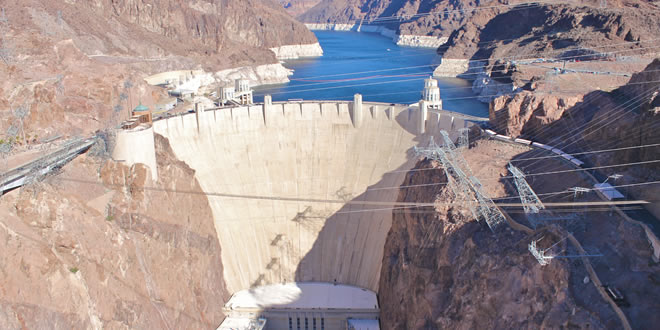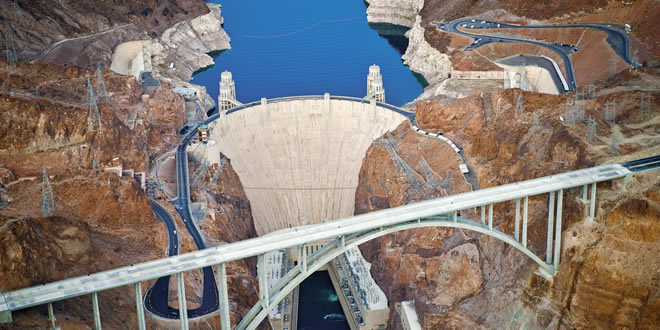The Hoover Dam
In the midst of the Great Depression, the Hoover Dam came to symbolize hope for many men and their families who came to live in the Nevada Desert as they searched for a paycheck. Rising over 700 feet above the raging waters of the Colorado River, the Hoover Dam was a reflection of engineering ingenuity that testified to boldness the world had never seen before. The man whom the dam was named after, the 31st President of United States and an engineer as well, Herbert Hoover, termed the dam as the greatest engineering work of its character ever attempted by the hand of man. Hoover Dam was an icon for modernity, paving way for an alliance between engineering and architecture. At 726 feet, the dam weighs more than 6.6 million tons. At its base are huge generators that could produce up to 3 million horsepower and provide electricity for three states.
History
The late 1880s were marked by farmers settling into the Imperial Valley next to the Colorado River. The tempestuous river was sometimes a peaceful river in the late summer, dwindling to a trickle by fall. However, as the seasons changed, a devastating flood caused by melting snow would completely submerge nearby farms leaving a wake of disaster in its path. As the 1920s rolled in, the necessity to tame this wild river had heightened and political forces called upon the Bureau of Reclamation to build dams for irrigation and soil conservation projects. Site testing was conducted to establish how to control the springtime flooding and channel the water where it was needed for irrigation, as well as provide hydroelectric power for people living in the region. Arthur Davis, the U.S. Reclamation Service’s director and chief engineer, set up a radical plan to build a dam of unprecedented height. Political efforts were called in to gain approval for this project as well as resolve the competing claims on the river by different western states. After years of lobbying, Congress finally approve the project which would be the largest building project the federal government had ever undertaken. Hoover, who was just elected as president, signed the bill into law in 1929.
Construction
Most construction companies around the country found the plan too ambitious and difficult to undertake. However, in 1931, a conglomerate of six small construction companies won the bid to build the structure. So massive was the project that it would take more than 200 engineers to design a dam that would divert the Colorado River through four massive tunnels blasted out of hard rock; pour 6.6 million tons of concrete to build the world’s largest concrete dam and build two giant spillways and four intake towers all in a remote desert region. No precedence had ever been set for a project so massive, calling on excellent planning and leadership to unite the efforts of an umbrella of six independent companies, thousands of laborers and the federal government.
Due to the remoteness of the region the first task at hand was to build roads and railroad lines as well as gather the materials that would be needed during construction closer to the site. This included millions of barrels of cement, structural steel components and large steel pipes along with fittings. Furthermore thousands of workers began to flood the region as they looked for work, which meant houses, roads, water and sewer lines had to be built. Eventually Boulder City was constructed in 1932 and it included dormitories, small cottages and a dining hall that served 6,000 meals a day. The inhabitants eventually created a small community, building makeshift school houses, a library and a church.
The work-space under which the dam would be erected had to be free of water and loose rock before a single bucket of concrete could be placed there. To achieve this, the river had to be diverted and four diversion tunnels were cut through the bedrock of the Black Canyon and lined with concrete. Two cofferdams were also put up to isolate the construction site and protect it from flooding. The diversion tunnels and the cofferdams were all completed before the spring floods of 1933. Once the engineers were sure that the dams would hold and the diversion tunnels could handle the flood waters, the actual building of the Hoover Dam took off.
To strip the canyon walls of loose rock, high-scalers were hired, chipping and shaving to create a smooth surface for the dam’s walls.They would do this by climbing down the canyon walls on ropes and working with jackhammers and dynamite to strip away the loose rock. The engineers were meticulous in ensuring there was no pathway for high-pressure leakage no matter what. Two large concrete plants were erected near the dam on the plateau solving many issues from procurement, handling, and storage of materials. When they finally started to pour concrete, the dam was poured in rows and columns of blocks. This would prevent the dam from cracking once it started to cool. Refrigerated water was then pumped through the blocks in pipes, and the pipes were then shot full of concrete, ensuring the dam remained in entirely one piece.
Engineers had initially estimated that it would take the dam 100 years to cool. With this approach, the dam cooled in just 20 months. The Hoover Dam became the first man-made structure to exceed the masonry mass of the Great Pyramid of Giza. The building of the dam also created Lake Mead, one of the largest man-made lakes in the world.

At the top of the dam, two spillways were designed to manage possible overflow from the river. They would protect the dam by ensuring water never went over the top in case of a flood. To pay for the construction of the dam, Congress mandated that electric power be sold. Such low cost energy would simulate the development of big cities and industries within the region. Excavation for the power plant was carried out the same time as with the dam but it was one of the projects uncompleted by the time of the formal dedication of the project. Four concrete intake towers were erected to supply water to the powerhouses. This water flowed down large steel penstocks to turn each turbine assembly in the power plant. The turbine would act as a giant waterwheel, turning a generator with a mighty thrust. Power generation began in 1936 and turbines continued to be added until 1961, when the last one went on line.
The government had set aside seven years for the actual completion of the dam. Engineers on the site managed to complete it two years ahead of schedule. On September 30, 1935 President Franklin D. Roosevelt dedicated the Hoover Dam (temporarily renamed Boulder Dam by the Roosevelt Administration and renamed for Hoover twelve years later in honor of his efforts on behalf of the project). Over 12,000 people attended the ceremony to witness the culmination of years of attempts to harness the power of the Colorado River.
When it was finished, Hoover Dam was the tallest dam in the world. It was also the largest producer of hydroelectric power in the world until 1948. Though it has since been overshadowed by other dams, the structure remains one of the biggest and best known dams in the world, drawing in millions of tourists.
The Value of the Hoover Dam
Aside from taming a wild river, the Hoover Dam went on to supply electricity that helped build the ships and planes used in World War II. Readily available low-cost energy helped to transform the Pacific Coast into a manufacturing center for planes and ships.
A canal system that connects the Imperial and Coachella Valleys with the Colorado River provides a means for farmers in the region to grow fresh vegetables and fruits that are supplied to the rest of the country.
Lake Mead, the first National Recreation Area in the United States, also continues to attract millions of visitors interested in boating, sailing, fishing and other recreational activities.


